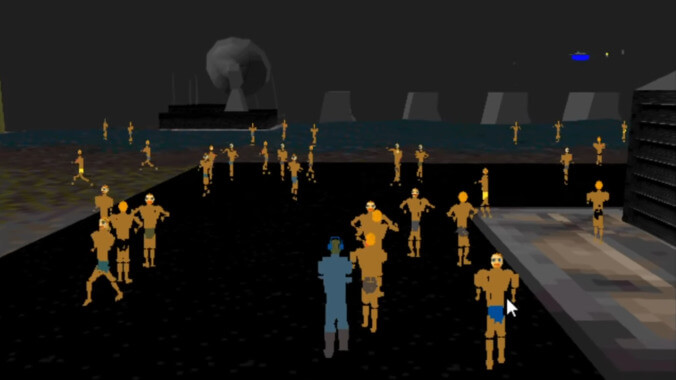SimCopter programmer once deployed armies of digital himbos for good

Since the internet has decided to throw us all neck-deep into the choppy waters of “himbo” discourse, our minds have been preoccupied with times when these kind, dim-witted, beautiful boys have played a role, large or small, in history. One example of this comes from a mostly-forgotten SimCity spin-off called SimCopter, which, thanks to the work of a frustrated programmer, thwarted an attempt to offer players the usual ‘90s video game sexism by replacing “bimbos” with muscly, affectionate doofuses in speedos.
The story of how SimCopter came to include riots of blockily-rendered bodybuilders has been detailed a few times over the years, including in a retrospective video by Chris Chapman. The SimCopter “bug” was created by programmer Jacques Servin, who, in an article from Wired about these “boy ‘bimbos’” published back in ‘96, said his job on the game was to design its characters. Servin says that the artist who “used my editor to make the bodies” was “aggressively heterosexual, and made several ‘bimbos’” that would show up in-game to celebrate stuff like finishing a mission. “At a certain point, I wondered, ‘Bimbos—why not studs?’” Servin recalled.
As a result of Servin’s work, SimCopter was sold with an unexpected feature where the game would mark certain days of the year (like Friday the 13th and his birthday) by flooding its streets with hunky dudes who walk around smooching each other. This was found later and Servin was fired before going on to co-create The Yes Men. In the Wired interview, he said his goal with the prank was “to make a point about how ‘heterosexual content is always implicit’ in computer games.” In Chapman’s video, though, Servin says he added the muscly characters because he was overworked on the game and actually came up with the greater “political” reasons later, when being interviewed constantly.
Regardless of motivation, the point is clear: Servin used “boy bimbos” as a way to express frustration and, in doing so, Trojan Horse’d subversive commentary into the game, whether it was well thought out beforehand or not. He saw the revolutionary potential of the himbo, creating his own digital handsome boy army to upend cultural expectations. When we look at Servin’s career as a prankster activist, it’s important to remember where it started: With frustration, good humor, and a solid understanding of what some friendly muscle guys can accomplish when put to good use.
Send Great Job, Internet tips to [email protected]